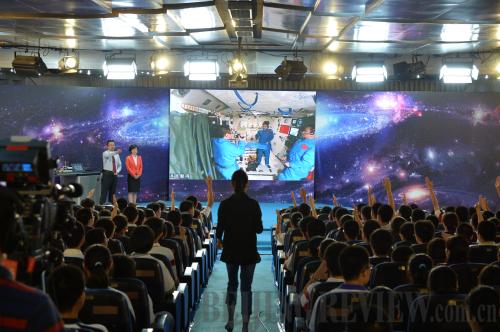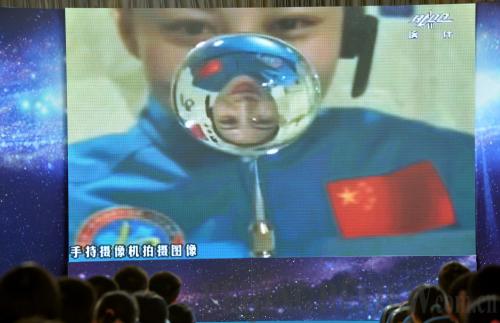|
 |
|
INTERACTIVE TEACHING: Students eagerly question astronauts aboard the Shenzhou-10 spacecraft via live video feed at the High School Affiliated to Renmin University of China in Beijing on June 20 LI XIN |
What is it like to live in a zero-gravity environment? What do astronauts eat and drink? How do they sleep? What do the stars look like in their eyes? Can they see any UFOs?
You might have known the answers from different channels, but none of them could have impressed you as directly as a live lecture by astronauts in space.
Wang Yaping, Nie Haisheng and Zhang Xiaoguang, three Chinese astronauts of the Shenzhou-10 spacecraft, gave such a lecture from the Tiangong-1 (Heavenly Palace) orbital laboratory module about 340 km above the Earth on June 20. The lecture was broadcast live to more than 60 million students and teachers at about 80,000 middle schools across China.
What it's like up there
Three hundred primary and middle school students present at the High School Affiliated to Renmin University in Beijing to communicate directly with the astronauts through a live video feed system.
Female astronaut Wang Yaping greeted students first. "Hello, everyone. I am Wang Yaping. I will host the lecture today," said Wang, who introduced her crew members Nie and Zhang. Nie would do a demonstration during the lecture while Zhang worked the camera.
The first section of the class was about weightlessness.
Nie Haisheng, commander of the crew, showed off by placing his legs into a meditation posture in midair, a feat which martial arts masters can only pull off in kungfumovies. Wang gave Nie a slight push and Nie floated backwardin slow motion and somersaulted effortlessly.
"Thanks to weightlessness, we are all kungfu masters," said Wang. "But you might wonder how we measure mass under such condition, since normal scales, working under the influence of gravity, don't function in orbit."
Then, she introduced the special scale on board the orbiter, which was designed on basis of the Newton's second law of motion, or measuring the mass of an object through net force and acceleration. Nie demonstrated how to use the "space scale."
 |
|
MAGIC SHOW: Astronaut Wang Yaping shows the surface tension of fluids in space (XINHUA) |
The next demonstration involved a small ball on a string fixed to a metal plate. Wang lifted the ball to the right side of the string and let the ball go. The ball did not swing as it usually does on Earth but suspended. But when she pushed the ball gently, the ball moved in a circular motion.
"As there is no gravity, even a slight push can make a big difference," said Wang, who then produced two gyros, one static and one rotating, to show the differences in movement when pushed.
The last part of the lesson was like a magic show with water to show the surface tension of fluids in space. Wang first demonstrated how they drink water in space. As water doesn't drop as it does on the Earth, the astronauts need to squeeze liquid from a bag and then catch the floating globules.
Then Wang put a metal ring into the water bag and when the ring came out, a bubble formed within the ring. The bubble didn't pop even as Wang swung the ring.
"Here comes the miracle," said Wang, who made another water membrane in the same way and put the ring upright. Then she started to add water to the bubble until it grew into a fluid globule.
Wang used an injector to create two bubbles in the ball of water and surprisingly, the bubbles didn't join each other, as they were held apart by surface tension. Then Wang pushed the bubbles out and injected red liquid into the ball, which gradually became glittering red.
| 